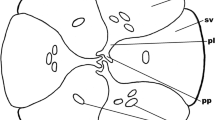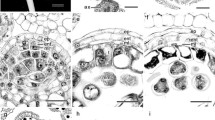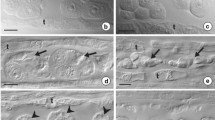Abstract
The anther wall layers ofCypripedium cordigerum are six to eight. The glandular tapetum is 2- or 3-layered and its cells are uninucleate. Simultaneous cytokinesis results in decussate, isobilateral and tetrahedral pollen tetrads. Ripe pollen grains are 2-celled. The mature ovules are anatropous, bitegmic and tenuinucellate. Both the integuments are dermal in origin and 2-layered. The inner integument alone forms the micropyle. The female gametophyte is 6-nucleate and bisporic. The reduction of nuclei is due to the “strike” phenomenon. Double fertilization occurs. The primary endosperm nucleus divides to form two free endosperm nuclei. The mature embryo is undifferentiated. The cells ca, m and n contribute to the embryo. The suspensor is single-celled. The seed coat is formed entirely by the outer layer of the outer integument. There are three sterile and three fertile valves in the ovary. In the prefertilization stages these valves consist of parenchymatous cells with starch and raphides. After fertilization, the sterile valves develop sclerotic cells whereas the fertile valves remain parenchymatous. The pericarp structure and embryological features support the retention of tribeCypripedieae within theOrchidaceae.
Similar content being viewed by others
References
Bentham, G., Hooker, J. D., 1883: Genera plantarum3. Orchideae, pp. 460–636. — London.
Carlson, M. C., 1940: Formation of the seed ofCypripedium parviflorum. — Bot. Gaz.102: 295–301.
—, 1945: Megasporogenesis and development of the embryo sac ofCypripedium parviflorum. — Bot. Gaz.107: 107–114.
Dahlgren, R., 1975: A system of classification of the angiosperms to be used to demonstrate the distribution of characters. — Bot. Notiser128: 119–147.
Davis, G. L., 1966: Systematic embryology of the Angiosperms. — New York: J. Wiley.
Dressler, R. L., Dodson, C. H., 1960: Classification and phylogeny in theOrchidaceae. — Ann Missouri Bot. Gard.47: 25–68.
Garay, L. A., 1960: On the origin of theOrchidaceae. — Bot. Mus. Leafl. Harvard Univ.19: 57–96.
Godfery, M. J., 1933: Monograph and iconograph of native BritishOrchidaceae. — Cambridge: Univ. Press.
Guignard, L., 1882: Recherches sur le développement de l'anthère et du pollen chez les Orchidées. — Ann. Sci. Nat. (Bot.) 6. sér.14: 26–45.
Hatch, E. D., 1954: Primary classification in theOrchidaceae. — Ceiba4: 222–224.
Kimura, C., 1967: On the embryo sac ofCypripedium debile Reichb. f. — Sci. Rep. Tôhoku Univ. Ser. IV (Biol.)34: 67–74.
Lindley, J., 1830–1840: The genera and species of Orchidaceous plants. — London.
Mansfeld, R., 1937: Über das System derOrchidaceae. — Blumea Suppl.1: 25–37.
Melchior, H., (Ed.) 1964:A. Engler's Syllabus der Pflanzenfamilien. — Berlin: Borntraeger.
Mohana Rao, P. R., Rao, K. M., 1983: Embryology ofLiparis viridiflora. — Acta Bot. Ind.11: 228–234.
Pace, L., 1907: Fertilization inCypripedium. — Bot. Gaz.44: 353–374.
Pfitzer, E., 1889:Orchidaceae. — InEngler, A., Prantl, K., (Eds.): Die natürlichen Pflanzenfamilien,II, 6, pp. 52–228. — Leipzig: Engelmann.
Poddubnaya-Arnoldi, V. A., 1960: Study on fertilization in the living material of some angiosperms. — Phytomorphology10: 185–198.
—, 1967: Comparative embryology of theOrchidaceae. — Phytomorphology17: 312–320.
Prosina, M. N., 1930: Über die vomCypripedium-Typus abweichende Embryosackentwicklung vonCypripedium guttatum Sw. — Planta12: 532–544.
Reichenbach, H. G., 1884: Über das System der Orchideen. — Bull. Congr. Int. Bot. Hortic. St. Petersburg4: 39–58.
Rolfe, R. A., 1909: The evolution of theOrchidaceae. — Orchid. Rev.17: 129–132.
Schlechter, R., 1926: Das System der Orchidaceen. — Notizbl. Bot. Gart. Mus. Dahlem9: 563–591.
Swamy, B. G. L., 1943: Gametogenesis and embryogeny ofEulophia epindendraea Fischer. — Proc. Natn. Inst. Sci. India9: 59–65.
—, 1945: Embryo sac and fertilization inCypripedium spectabile. — Bot. Gaz.107: 291–295.
—, 1947: On the life history ofVanilla planifolia. — Bot. Gaz.108: 449–456.
—, 1949a: Embryological studies in theOrchidaceae. 1. Gametophytes. — Amer. Midl. Naturalist41: 184–201.
—, 1949b: Embryological studies in theOrchidaceae. 2. Embryogeny. — Amer. Midl. Naturalist41: 202–232.
Thorne, R. F., 1976: A phylogenetic classification of the angiosperms. — InHecht, M. K., Steere, W. C., (Ed.): Evolutionary biology9: 35–106. — New York.
Treub, M., 1879: Notes sur l'embryogénie de quelques Orchidées. — Nat. Verh. Akad. Amsterdam19: 1–50.
Vermeulen, P., 1966: The system of theOrchidales. — Acta Bot. Neerl.15: 224–253.
Wirth, M., Withner, C. L., 1959: Embryology and development in theOrchidaceae. — InWithner, C. L., (Ed.): The orchids — a scientific survey, pp. 155–188. — New York.
Author information
Authors and Affiliations
Rights and permissions
About this article
Cite this article
Sood, S.K., Mohana Rao, P.R. Studies in the embryology of the diandrous orchidCypripedium cordigerum (Cypripedieae, Orchidaceae). Pl Syst Evol 160, 159–168 (1988). https://doi.org/10.1007/BF00936043
Received:
Issue Date:
DOI: https://doi.org/10.1007/BF00936043




